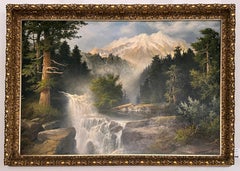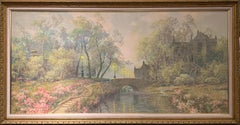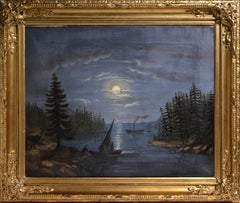A.D. Greer Art
Oklahoma-born artist A.D. Greer had a talent for filtering out the undesirable elements of his environment — pushing any ugliness or unpleasantness from his mind as he painted — to bring the beauty of the land to the forefront. His immersive paintings transport the viewer in an instant to a calm lakeshore or a quiet country road.
Born Aubrey Dale Greer in Oklahoma City, the artist’s mother died when he was three. His family moved – by covered wagon — to Kansas where he grew up. Greer had a brief boxing career after graduating from St. John's Military Academy in Salina, but when the Great Depression brought the economy to a screeching halt, Greer took on whatever work he could get, including lumberjacking and setting spikes on the railroad.
Greer was able to supplement the income he earned as a laborer by doing decorative painting and murals on water towers, smokestacks and restaurant walls. He credited his artistic talents for keeping him flush throughout the greatest economic downturn in American history.
In 1934, Greer opened a studio in Oklahoma City where he painted stage curtains for theaters around the country. He painted with a realistic style that surpassed his counterparts in the business, and his curtains saw great demand. Hiring a group of traveling salesmen, Greer found modest success.
Greer continued to produce proper landscape paintings, and was eventually approached by his friend, American painter Leonard Woodruff, to allow the International Art Publishing Company of Detroit to publish two of his works for free. He agreed, and the works sold over a million copies. Greer saw no compensation for those sales, but his name and reputation spread all over the United States.
Greer continued to create vivid, beautiful landscapes and other types of paintings until he died in 1998.
Find authentic A.D. Greer paintings on 1stDibs.
1980s Realist A.D. Greer Art
Canvas, Oil
1980s American Impressionist A.D. Greer Art
Canvas, Oil
Late 19th Century Realist A.D. Greer Art
Canvas, Wood, Cotton Canvas, Oil
1890s Realist A.D. Greer Art
Canvas, Oil
Mid-20th Century Realist A.D. Greer Art
Canvas, Oil
Early 20th Century Realist A.D. Greer Art
Canvas, Wood, Cotton Canvas, Oil
20th Century American Impressionist A.D. Greer Art
Oil, Canvas
20th Century American Impressionist A.D. Greer Art
Oil, Canvas
Early 1900s American Impressionist A.D. Greer Art
Canvas, Oil
1980s Realist A.D. Greer Art
Oil, Canvas
20th Century American Impressionist A.D. Greer Art
Canvas, Oil
1930s American Impressionist A.D. Greer Art
Oil, Canvas
Late 19th Century Realist A.D. Greer Art
Canvas, Wood, Oil
Early 1900s American Impressionist A.D. Greer Art
Canvas, Oil



